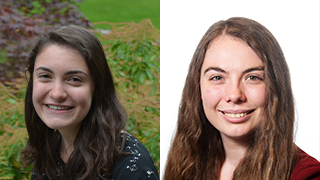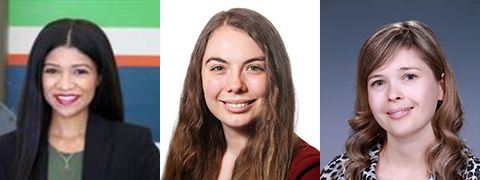PNNL @ NeurIPS 2021
Researchers to address topics ranging from deception detection to climate change

Pacific Northwest National Laboratory (PNNL) data scientists and engineers will be presenting 11 papers, posters, and workshops between NeurIPS, the Thirty Fifth Conference on Neural Information Processing Systems, and the co-located Women in Machine Learning workshop, WiML. Held virtually this year from December 6 through December 14, NeurIPS provides an international platform for the exchange of information related to neural information processing systems research.
At PNNL, researchers are advancing the frontiers of scientific research and national security by applying artificial intelligence (AI) and advanced computing to scientific problems.
Below is a full list of PNNL presenters who will share their research in AI and machine learning at NeurIPS and WiML.
PNNL Presentations, Posters, and Workshops
Machine learning structure preserving brackets for forecasting irreversible processes
Poster Session 2
Poster | December 7 | 4:30 p.m. PST

Authors: Kookjin Lee (Arizona State University) · Nathaniel Trask (Sandia National Laboratories) · Panos Stinis
Forecasting of time-series data requires imposition of inductive biases to obtain predictive extrapolation, and recent works have imposed Hamiltonian/Lagrangian forms to preserve structure for systems with reversible dynamics. In this work, we present a novel parameterization of dissipative brackets from metriplectic dynamical systems appropriate for learning irreversible dynamics with unknown a priori model forms. The process learns generalized Casimirs for energy and entropy guaranteed to be conserved and nondecreasing, respectively. Furthermore, for the case of added thermal noise, we guarantee exact preservation of a fluctuation-dissipation theorem, assuring thermodynamic consistency. We provide benchmarks for dissipative systems, demonstrating that learned dynamics are more robust and generalize better than either "black-box" or penalty-based approaches. VIEW SESSION.
On the Stochastic Stability of Deep Markov Models
Poster Session 4
Poster | December 8 | 4:30 p.m. PST

Authors: Jan Drgona · Sayak Mukherjee · Jiaxin Zhang (Oak Ridge National Laboratory) · Frank Liu (Oak Ridge National Laboratory) · Mahantesh Halappanavar
Deep Markov models (DMMs) are generative models that are scalable and expressive generalizations of Markov models for representation, learning, and inference problems. However, the fundamental stochastic stability guarantees of such models have not been thoroughly investigated. In this paper, we present a novel stability analysis method and provide sufficient conditions of DMM's stochastic stability. The proposed stability analysis is based on the contraction of probabilistic maps modeled by deep neural networks. We make connections between the spectral properties of neural network weights and different types of used activation functions on the stability and overall dynamic behavior of DMMs with Gaussian distributions. Based on the theory, we propose a few practical methods for designing constrained DMMs with guaranteed stability. We empirically substantiate our theoretical results via intuitive numerical experiments using the proposed stability constraints. VIEW SESSION.
AI-Driven Predictive Analytics to Inform Nuclear Proliferation Detection in Urban Environments
Women in Machine Learning Workshop
Paper | December 10

Authors: Anastasiya Usenko · Joonseok Kim · Ellyn Ayton · Svitlana Volkova
Unattended radiological sensor networks must take advantage of contextual data, e.g., open-source data in addition to historical sensor signals to anticipate nuclear isotope signatures and mitigate nuisance alarms in urban environments. To address these challenges, we have developed novel AI-driven predictive analytics—using machine learning and deep learning models—to predict radiological isotope signatures by learning from historical sensor data for 9 months in Washington, DC and 7 months in Fairfax, VA in 2019 and 2020. Our sensor data includes alerts from three medical isotopes—Tc-99m, I-131, and 511 from positron emission tomography—and one industrial Cs-137 isotope. VIEW SESSION.
Across the Pond and Back: Evaluation of News Deception Detection Approaches Across Natural and Synthetic Regional Dialects
Women in Machine Learning Workshop
Paper | December 10

Authors: Robin Cosbey · Maria Glenski
The need for deceptive news detection on social media platforms has grown significantly in the last several years. In 2018, about half of consumers expected the news they received on social media to be largely inaccurate, and surveys from 2021 have revealed that 57% of adults would like to see steps taken to restrict the spread of false information online [1]. Although several approaches have been proposed, most rely on standard performance metrics and test datasets that do not effectively capture underlying biases or model dependencies—they answer the question of how the model is performing but not why or within what circumstances the model will perform in this way. Recent work has also shown models display biases toward certain dialects—e.g., “California English” [2]. Standard test data used to evaluate model performance is not likely to be representative across variations, such as regional or dialectic differences in language, that the model will encounter when deployed in a real-world setting. In this work, we explore the effect of natural and simulated dialect variations have on deception detection model performance with American and British news headlines collected from Reddit in 2019 and 2020. VIEW SESSION.
Evaluating the Impact of Embedding Representations on Deception Detection
Women in Machine Learning Workshop
Paper | December 10

Authors: Ellyn Ayton · Maria Glenski
Contextualized word embeddings underpin most state-of-the-art machine learning models used in natural language processing, natural language understanding, and more. With the ever-increasing number of models, there are a multitude of options to choose from, and it can be difficult to assess the strengths, weaknesses, or biases of these models. For the average machine learning practitioner, pretrained embeddings can seem like black boxes because pretraining requires significant computational resources and time and removes control or identification of biases present in training data that can affect downstream behavior. In this ongoing work, we evaluate the extent to which the choice of pretrained embeddings affects downstream performance on a deception detection task. VIEW SESSION.
Studying the Cause and Effect in Scientific Productivity with Research Portfolios
Women in Machine Learning Workshop
Paper | December 10

Authors: Jasmine Eshun · Maria Glenski · Svitlana Volkova
Causality helps connect the dots between cause and effect beyond a simple correlation. Here, causal analysis is used as a tool to describe research influences and trends, specifically aiming to make connections and predictions about scientific productivity based on a scientist’s research portfolio in the area of computational linguistics. Studying these research trends is a valuable way to gain insight on a particular discipline. In this study, the ACL Anthology dataset is processed into a format that can be used to identify causal influences of research trends and research productivity, with both causal discovery and pairwise causal effect estimation. VIEW SESSION.
Differentiable Parametric Optimization Approach to Power System Load Modeling
Differentiable Programming Workshop
Paper | December 13 | 6:00 a.m. PST

Authors: Jan Drgona · Shrirang Abhyankar · Andrew August · Aaron Tuor · Elliott Skomski
In this work, we propose a differentiable programming approach to data-driven modeling of distribution systems for electromechanical transient stability analysis. Our approach combines the traditional ZIP load model with a deep neural network formulated as a constrained nonlinear least-squares problem. We will discuss the formulation, setup, and training of the proposed model as a differentiable program. Finally, we will compare and investigate the performance of this new load model and present the results on a medium-scale 350-bus transmission-distribution network. VIEW SESSION.
Neural Differentiable Predictive Control
Differentiable Programming Workshop
Paper | December 13 | 6:00 a.m. PST

Authors: Jan Drgona · Aaron Tuor · Draguna Vrabie
We present a neural differentiable predictive control (DPC) method for learning constrained neural control policies for uncertain linear systems. DPC is formulated as a differentiable problem whose computational graph architecture is inspired by a classical model predictive control (MPC) structure. In particular, the optimization of the neural control policy is based on automatic differentiation of the MPC loss function through a differentiable closed-loop system dynamics model. We show that DPC can learn constrained neural control policies to stabilize systems with unstable dynamics, track time-varying references, and satisfy state and input constraints without the prior need for a supervisory MPC controller. VIEW SESSION.
Digital Twin Earth Coasts: Developing a fast and physics-informed surrogate model for coastal floods via neural operators
Machine Learning and the Physical Sciences Workshop
Paper | December 13 | 6:00 a.m. PST

Authors: Peishi Jiang · Nis Meinert (German Aerospace Center) · Helga Jordão (University of Lisbon) · Constantin Weisser (Massachusetts Institute of Technology) · Simon Holgate (IBM Research) · Alexander Lavin (Institute for Simulation Intelligence) · Björn Lütjens (Massachusetts Institute of Technology, IBM Research) · Dava Newman (Massachusetts Institute of Technology) · Haruko Wainwright (Lawrence Berkeley National Laboratory) · Catherine Walker (National Aeronautics and Space Administration, Woods Hole Oceanographic Institution) · Patrick Barnard (United States Geological Survey)
Developing fast and accurate surrogates for physics-based coastal and ocean models is an urgent need because of the coastal flood risk under accelerating sea level rise and the computational expense of deterministic numerical models. For this purpose, we develop the first digital twin of Earth coastlines with new physics-informed machine learning techniques, extending the state-of-the-art neural operator. As a proof-of-concept study, we built Fourier neural operator (FNO) surrogates on simulations of an industry-standard flood and ocean model (NEMO). The resulting FNO surrogate accurately predicts the sea surface height in most regions while achieving upwards of 45× acceleration of NEMO. We delivered an open-source CoastalTwin platform in an end-to-end and modular way to enable easy extensions to other simulations and machine-learning-based surrogate methods. Our results and deliverable provide a promising approach to massively accelerate coastal dynamics simulators, which can enable scientists to efficiently execute many simulations for decision-making, uncertainty quantification, and other research activities. VIEW SESSION.
Safe Reinforcement Learning for Grid Voltage Control
Safe and Robust Control of Uncertain Systems Workshop
Paper | December 13 | 8:00 a.m. PST

Authors: Thanh Long Vu · Sayak Mukherjee · Renke Huang · Qiuhua Huang
Undervoltage load shedding has been considered as a standard approach to recover the voltage stability of the electric power grid under emergency conditions. However, this scheme usually trips a massive amount of load inefficiently. Reinforcement learning (RL) has been adopted as a promising approach to circumvent these issues, but it usually cannot guarantee the safety of the systems under control. In this paper, we discuss a few novel safe RL approaches—namely a constrained optimization approach and a Barrier function-based approach—that can safely recover voltage under emergency events. This method is general and can be applied to other safety-critical control problems. Numerical simulations on the 39-bus IEEE benchmark are performed to demonstrate the effectiveness of the proposed safe RL emergency control. VIEW SESSION.
Reward-Free Attacks in Multi-Agent Reinforcement Learning
Learning in the Presence of Strategic Behavior Workshop
Poster | December 13 | 9:00 a.m. PST

Authors: Ted Fujimoto · Timothy Doster · Adam Attarian · Jill Brandenberger · Nathan Hodas
We investigate how effective an attacker can be when it only learns from its victim's actions, without access to the victim's reward. In this work, we are motivated by the scenario where the attacker wants to behave strategically when the victim's motivations are unknown. We argue that one heuristic approach an attacker can use is to maximize the entropy of the victim's policy. The policy is generally not obfuscated, which implies it may be extracted simply by passively observing the victim. We provide such a strategy in the form of a reward-free exploration algorithm that maximizes the attacker's entropy during the exploration phase, and it then maximizes the victim's empirical entropy during the planning phase. In our experiments, the victim agents are subverted through policy entropy maximization, implying an attacker might not need access to the victim’s reward to succeed. Hence, even if the victim's reward information is protected, reward-free attacks, based only on observing behavior, shows the feasibility of an attacker to act strategically without knowledge of the victim's motives. VIEW SESSION.
Tackling Climate Change with Machine Learning
Workshop
Workshop | December 14 | 5:00 a.m. PST

Organizers: Maria João Sousa (Instituto Superior Técnico, University of Lisbon) · Hari Prasanna Das (University of California, Berkeley) · Sally Simone Fobi (Columbia University) · Jan Drgona · Tegan Maharaj (Mila, University of Toronto) · Yoshua Bengio (Mila, University of Montréal)
The focus of this workshop is the use of machine learning to help address climate change, encompassing mitigation efforts (reducing greenhouse gas emissions), adaptation measures (preparing for unavoidable consequences), and climate science (our understanding of the climate and future climate predictions). The scope of this workshop includes climate-relevant applications of machine learning to the power sector, buildings and transportation infrastructure, agriculture and land use, extreme event prediction, disaster response, climate policy, and climate finance. The goals of the workshop are: (1) to showcase high-impact applications of ML to climate change mitigation, adaptation, and climate science, (2) to showcase novel and interesting problem settings and challenges for ML techniques, (3) to encourage fruitful collaboration between the ML community and a diverse set of researchers and practitioners from climate change-related fields, and (4) to promote dialog with decision-makers in the private and public sectors to ensure that the work presented leads to responsible and meaningful deployment. VIEW SESSION.